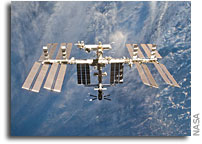NASA ISS Weekly Research Highlights Week of January 16, 2012

Capillary Flow Experiments – 2 (CFE-2) is a suite of fluid physics investigations that study how fluids move up surfaces in microgravity. Don Pettit completed the clockwise wetted surface test for the vane gap 2 unit of CFE-2. He made measurements on the critical wetting angles for eight different conditions by adjusting vane angles based primarily on his real-time observations. The results aim to improve current computer models that are used by designers of low gravity fluid systems and may improve fluid transfer systems for water on future spacecraft. On Earth, CFE-2 results are also being considered for improving fluid flow in miniaturized biological devices used for health screening and analysis.
Test operations began for the Flame Extinguishment Experiment -2 (FLEX-2). FLEX-2 encompasses five distinct investigation classes using pure and bi-component mixed fuels. The first investigation class is fuel surrogates. Surrogate fuels are mixtures of pure fuels that simulate the behavior of real fuels, such as gasoline and jet fuels. Surrogate fuels are chosen for investigation because they allow insight into the burning characteristics of real fuels, which are very difficult to study because they are multi-component. The results from these test points will lead to greater fuel efficiency of liquid-fuel engines and will minimize pollutant emissions. On Earth, FLEX-2 will help in the understanding of combustion generated pollution, and address fire hazards associated with using liquid combustibles.
Andre Kuipers and Don Pettit completed more sessions of the Cardiac Atrophy and Diastolic Dysfunction During and After Long Duration Spaceflight: Functional Consequences for Orthostatic Intolerance, Exercise Capability and Risk for Cardiac Arrhythmias (Integrated Cardiovascular). This investigation determines how much cardiac atrophy, or decrease in heart muscle, occurs during spaceflight and how fast it develops, whether this atrophy causes problems with the heart’s pumping or electrical function, and how both the atrophy and any associated changes develop. On Earth, the information obtained in this investigation has relevance for patients after prolonged confinement to bedrest, or chronic reduction in physical activity, as well as for patients with disease processes that alter cardiac stiffness such as congestive heart failure.
In conjunction with Integrated Cardiovascular, Pettit completed a session with Vascular Echography (Vessel Imaging). This European Space Agency investigation evaluates the changes in thickness and compliance of blood vessel wall properties and cross sectional areas of crew members during and after long-term exposure to microgravity.
Pettit completed the ultrasound portion of his second session with the Integrated Resistance and Aerobic Training Study (SPRINT). This investigation evaluates the use of high intensity, low volume exercise training to minimize loss of muscle, bone and cardiovascular function in station crew members during long-duration missions. Data gathered from the investigation may help scientists develop or enhance aerobic training and resistance protocols that may be used on Earth to aid in muscle, bone and cardiovascular health.
Crew members continue weekly entries for the Behavioral Issues Associated with Isolation and Confinement: Review and Analysis of Astronaut Journals (Journals) investigation. This study, which requires three entries per week, obtains information on behavioral and human issues that are relevant to the design of equipment and procedures and sustained human performance during extended-duration missions. Study results will provide information to help prepare for future space missions and could help to improve the behavioral performance of people living and working under a variety of conditions here on Earth.
Thirty-seven runs of the Selectable Optical Diagnostics Instrument – Diffusion and Soret Coefficient (SODI-DSC) have been completed and confirmed valid. This European Space Agency investigation studies diffusion in six different liquids over time in the absence of convection induced by the gravity field.
Pettit completed his first sampling session of the Japan Aerospace Exploration Agency’s Biomedical Analyses of Human Hair Exposed to a Long-term Space Flight (Hair) investigation. Hair root cells actively divide in the hair follicle, and they sensitively reflect physical conditions. It is believed that by examining human hair the scientists can determine the stress levels and metabolic conditions of a human caused by the microgravity environment and cosmic radiation. The purpose is to study the effects of long-term exposure in spaceflight on gene expression and mineral metabolism in human hair.
Jorge Sotomayor, Lead Increment Scientist Expedition 29/30









